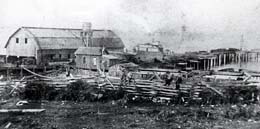On August 14, 1890, Edmonds, Washington, becomes incorporated when Washington Secretary of State Allen Weir files the order creating it as a fourth-class town. The process leading toward this result had begun months earlier and included action by local citizens, Snohomish County commissioners, a local election, and even, according to local legend, several four legged residents. With town founder George Brackett (1842-1927) as its first mayor and a five member council, the new town will soon adopt crucial ordinances to effect local governance and to set a social climate. Thus, Edmonds prepares to evolve from a seaside village to a thriving city during the twentieth century.
Brackett's Bull and Others
Bollivar Brackett and Bill Brackett were among the Edmonds residents whose names appeared in the census count as their seashore village sought incorporation in the spring of 1890. The two did indeed live in the community, but neither was truly eligible to participate in such an undertaking, for Bollivar was a bull and Bill a cattle dog owned by town founder George Brackett. When Brackett’s zeal to incorporate reached a snag because the population fell two short of the three hundred residents required, townspeople simply listed their names. And who would ever know? So the legend goes. Alas, there is no evidence it is true! (Nor is a later version any more reliable: that Bolivar [sic] and Isaac Brackett were two oxen whose names appeared on the petition requesting action toward incorporation.)
Brackett was clearly the person most likely to lead an incorporation effort for he was and is generally considered the town founder. Although he was not the first person to own property along the beach that became Edmonds, Brackett¹s purchase of 147 acres there in 1870 was pivotal. He platted and sold properties, started a shingle mill, drained marshes, built a wharf, and generally led in turning a stretch of beach and its timbered hillside into a town. Perhaps it was inevitable that the effort to incorporate followed. Edmonds publisher and historian Ray V. Cloud, incidentally, wrote in 1953 that his own research efforts failed to bring to light any evidence to substantiate the oxen story that had been handed down by early settlers (Cloud, p. 12).
The petition prompted the incorporation procedure to get underway. At their June 7 meeting the Snohomish County commissioners set town boundaries and called for a census; a formal order followed on June 23. An election was scheduled for August 7 at the town hall with a three-member election board headed by Justice of the Peace George P. Bartlett. That day a majority of the citizens favored the incorporation of Edmonds, which would encompass some 600 acres that stretched along the waterfront and up the hill to the east. Brackett had been elected the first mayor, along with C. T. Roscoe (1844-1919) as treasurer and a council made up of Fred L. Brown (d. 1933), William H. Hamlin, William Plummer, Peter S. Schreiber (1859-1913), and Wellington F. Smith (1845-1899). Hamlin, Plummer, and Roscoe would also later serve terms as mayor and Roscoe became Snohomish County Prosecuting Attorney.
The Snohomish County Council confirmed the election at their August 11 meeting, and on August 14, 1890, Washington Secretary of State Allen Weir formally filed the order creating Edmonds as a fourth-class town.
Conducting Town Business
The city council met for the first time on August 20, and began the process of governance, authorizing a clerk who would procure books and a seal for the town. Over the next several weeks a marshal, a police justice, and a street commissioner were duly appointed. Several were designated salaries that were based on their levels of activity. The marshal, for instance, received a salary fixed at 5 percent of all taxes and licenses collected by him and $1.00 for each arrest plus costs for boarding any prisoners.
Other actions taken that fall showed concern for Edmonds's social climate. Ordinance Number One established licensing for the distribution of any liquor, wine, beer, or intoxicating beverages; this was replaced by far more comprehensive legislation 24 years later. The second ordinance outlawed any boarding house, house of ill fame or any place for the practice of prostitution or, as a handwritten note in the margin suggested, bawdy houses.
Successive legislation dealt with the licensing of dogs and bitches, the abatement of such nuisances as the slaughter of animals and burning of rubbish, the licensing of theaters, shows, exhibitions and public amusements, and of auctioneers, hawkers, and peddlers. Not for a year did the council get around to confronting such basic governmental matters as property assessments and taxation.
A municipal election in December 1890 brought slight changes in the slate of city officials. Mayor Brackett was replaced by Councilman William H. Hamlin, a well known Puget Sound navigator who had arrived in 1881, purchased large land holdings, and built a wharf.
Eighteen years after its incorporation Edmonds was elevated to a third-class town -- a designation no longer in use - and in 1970 it was empowered to adopt its own code. In 2010 the city continued to have a strong mayor form of government with a seven-member city council. Its boundaries had expanded substantially over the decades especially to the east of the shoreline and north, and they included 8.9 square miles of land. With a population hovering around 41,000 and quite likely no oxen -- Edmonds was the 22nd largest city in the state.

